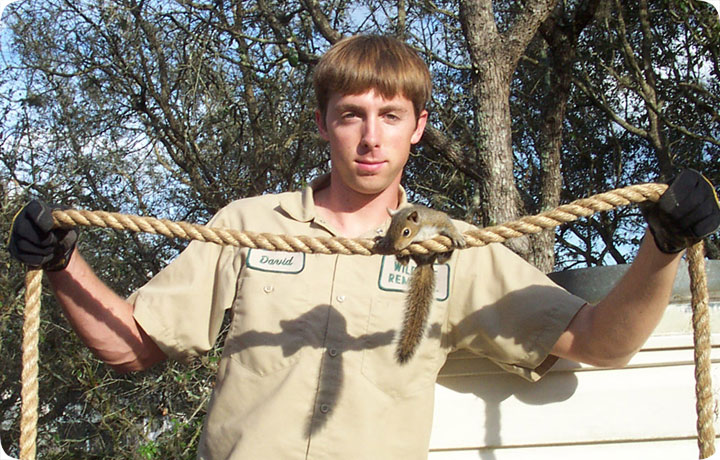-
info@aaanimalcontrol.com
Call us for help in your town
Humane Wildlife Education
Removing a Squirrel from a Chimney Flu

I came to the home and took apart the rainguard over the flu. I found the squirrel nest and removed two other young squirrels, and the mother squirrel ran off. I then shone a flashlight down the flu, and there was the little squirrel, still stuck. I carry a long, thick length of sisal rope with me at all times, for just such occasions. Squirrels commonly fall down these flues. They think that they can climb anything, and in nature, they can. But there's nothing in nature like a slick steel vertical tube, so when they fall down, they find that it's one thing they can't climb.
I lowered my rope down the chimney. Squirrels in these cases can be very stubborn, and I have to leave the rope down there for a long time, sometimes days, before the squirrel will bother to climb out. But this time, the squirrel grabbed right onto the rope, and clung on, and I simply pulled it up to safety. It then stayed on the rope, and the homeowner, who climbed on the roof to investigate, took this photograph of me.
I used the little squirrels to lure the mama squirrel into a trap, and then I relocated all of them together to a new area. I put a steel screen on the flu and reassembled the rain guard, and the job was done.
Do it yourself: Visit my How To Get Rid of Squirrels page for tips and advice.
Get professional help: Visit my Nationwide Pro Directory of wildlife removal experts.
The Eastern Gray Squirrel (Sciurus carolinensis), is one of the most widespread nuisance animals in the country. It lives throughout most of the United States. It is arboreal (likes to live in trees), but just as commonly atticeal (likes to live in attics). It's a member of the rodent family, and is prone to chewing and gnawing. Squirrels are active during the daytime, particularly morning and evening. They are active year-round. They give birth to two litters of young per year, in late summer and late winter, commonly inside buildings they've chewed into. They are very agile and great climbers, and are active animals. They are cute, but often destructive, especially when they enter an attic.
For more wildlife stories, click my Wildlife Blog, or click my below banner to hire a local trapper.





















